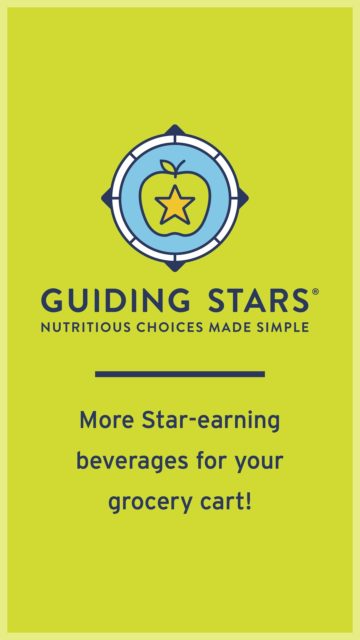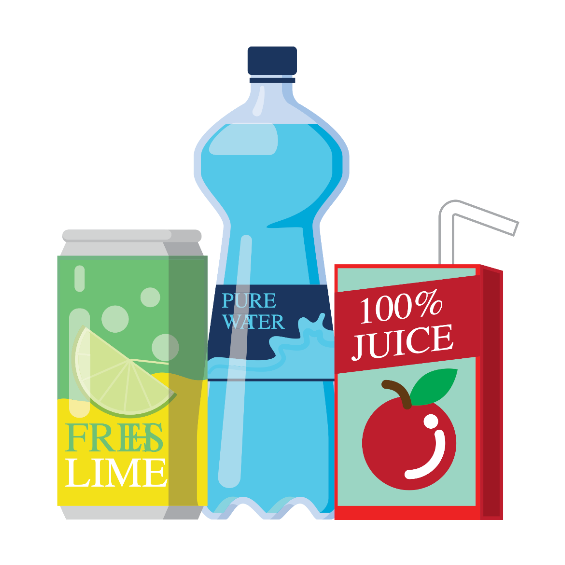
We’ve all heard to drink plenty of water each day, but is water the only good option for hydration and nutrition? The grocery store shelves are brimming with all sorts of old and new drinks such as functional beverages, kombuchas, and plant waters. How can consumers sift through the vast array and know which ones are best for their health?
When the Guiding Stars program was first developed over 15 years ago, a decision was made to evaluate foods and beverages based on nutrient density, defined as the ratio of nutrient content to energy content. That is, foods that pack in lots of beneficial nutrients without lots of calories, have a high nutrient density. In order to calculate this all products must first be standardized to a specific energy amount, in our case a 100-kcal serving size, so that the nutrient content of products per fixed energy content could be determined and scored. This worked well for nearly all products in the grocery store with the notable exception of water and other no calorie or very low-calorie items.
While water is vital to life, it has no calories and contains no nutrients. Thus, it was impossible to standardize water to a 100-kcal serving size. And even if that had been possible, it would have received no credits in the original Guiding Stars algorithms as it has no beneficial dietary components, and in turn would not have earned any stars. Given this limitation of our original algorithms, water and other no calorie or very low calorie (≤5 kcals) items such as flavored seltzers and unsweetened teas were exempt from evaluation. There was signage in the water aisle explaining that water is a great choice but not evaluated with the Guiding Stars program. Most other caloric beverages ranging from juices to coffee drinks and sodas were rated with our original General Foods & Beverages algorithm while milks with inherently different nutrient profiles were rated with the Meats, Seafood, Poultry, Dairy, & Nuts algorithm. Nonetheless, our guidance on beverages was incomplete.
The United States is grappling with an obesity epidemic and the rates of overweight and obesity are at all-time highs. Much of this issue has been attributed to an excess intake of added sugars, and sugar sweetened beverages are the number one contributor of calories and added sugars in the American diet. The beverage industry is also rapidly changing with the introduction of new categories of drinks such as prebiotic or probiotic sodas and fermented teas. Many of these products have new formulations or novel ingredients that are unfamiliar to consumers. We felt the time had come for us to provide complete guidance on beverages, and help steer people toward choices that promote health, and help decrease the risk of chronic diseases linked to being overweight and obese.
So how to accomplish this? The Guiding Stars Scientific Advisory Panel went back to the drawing board and spent two full years researching, developing, and testing an algorithm to evaluate and rate beverages. Initially, we investigated what makes a drink a good choice, and how beverages can be differentiated in a meaningful way. Our goal was to identify products that first provide hydration, and may bring along other ingredients that positively impact health such as vitamins and live active cultures. However, they should not have an excess of sugar—whether added or naturally occurring—nor should they contain too much of other potentially negative dietary components such as added sodium and chemical additives.
To evaluate beverages, a new volume-based serving size would be necessary as many products in this category contain few or no calories. We opted to go with a 12-ounce serving size, which is the FDA’s Reference Amount Customarily Consumed (RACC) for most beverages including water, sodas, teas, and coffees. For our purposes, beverages were defined as products that provide hydration, are in liquid form, are intended to be consumed on their own in their sold as state and are not meant to replace a meal or be used for medicinal purposes.
All beverages are initially given 3 baseline points for providing hydration, as waters cannot otherwise earn nutrient based credits. They are then awarded additional credits for the presence of these positive dietary components: Vitamins & Minerals, Fiber, and Live Active Cultures.
Likewise, beverages are debited if they contain excess amounts of negative dietary components which can contribute to overweight/obesity, or metabolic syndrome conditions including hypertension and elevated cholesterol. These are: Added Sugars, Natural Sugars, Added Sodium, and Saturated Fat.
Beverages are also debited for the presence of additives to limit including artificial colors and flavors, non-nutritive synthetic sweeteners, and chemical preservatives, as products containing them are highly processed, tend to be of lower nutritional quality, and are not the best choices for consumers—especially when compared to water.

Beverages Algorithm
- More
- Fiber
- Vitamins
- Minerals
- Live Active Cultures
- Less
- Added Sugars
- Natural Sugars
- Saturated Fat
- Added Sodium
- Additives to Limit
If a beverage passes through these steps without receiving any debits whatsoever and contains no added sodium or added sweeteners of any kind, it is awarded an additional 3 points. Finally, as is done with the other models, the product scores are translated into star ratings. Only beverages with scores greater than zero, indicating that the positive attributes of the product outweigh the negative ones, are eligible for star ratings.
We opted to adapt this very rigorous set of criteria so that we can confidently recommend the absolute best beverage choices to consumers. We are thrilled that after all these years we can finally provide complete guidance on beverages and help people navigate the ever-evolving new trends in the beverage aisle. Let’s toast to good health! Cheers!